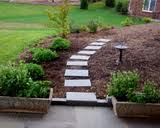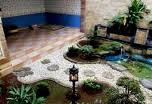History of The Pathways
In the days of ancient Britain, the path functions as a circulation path for directing movement of a person leading to the house after passing through the fence. The path is needed because the area surrounding the home page (often like a small forest) can cause a guest to get lost.
Besides English, the path is also used in Japanese gardens ( called "Tobi Ishi"). Tobi-Ishi is the typical style of the gardens at "drinking tea house" for guests who will enter the "drinking tea house", do not set foot on moss-covered garden area. In addition, the path is also a symbol of artificial elements blend with nature. The path is generally compiled straight into interesting accent among Japanese garden composition which tends to monotony because of the influence of Zen.
Pathways Function
Functions path is to limit the area of the park with one another (at the time of England). If you have a very wide area, people can make a few theme parks in one page. For example, a kitchen garden, rose garden and fountain area or water fountain. Between the different theme parks, separated by walkways. The function of this pathway to replace the fence or wall by the use of fences or walls as composition elements can ruin a whole garden. The presence of fences and walls will make the park look fragmented and feel cramped.In addition, the path functions as a circulation path that allows one to reach all parts of the park, without having to trample grass or soil and can improve the aesthetics of the park.For a small garden, does not provide any path.
Current Pathways
Today very few people who have extensive pages. Most only have a narrow area. Now, the path function only to improve park aesthetics. The path can be an interesting accent in the middle of a verdant expanse of grass or a group of colorful flowers. It also serves as a footrest, especially when watering the plants.
Planning
To be an element that is very interesting and add to the beauty of gardens, paths need to be planned properly. Include the laying and selection of shapes and building blocks of the path. Do not disturb the aesthetics of the trail laying of the park.As a benchmark, a path is usually made to connect the park with the pavement around the house, for example carpot or terrace. Take also, for the position of the path allows you to reach all parts of the park, especially when watering the plants. If you want to cross footing with grass, make sure that the distance between the footing and the other one is not too far or too close. Too far can cause people to slip and fall. While the distance is too close to make a foot less comfortable and, if deemed compositions look less good.
For shape, you can choose a geometric pattern or natural. Geometric pattern is represented by irregular angular shapes and laying stones over specific intervals. While many adopted the natural pattern of curved shapes and irregular curves.The following tips are worth trying: for ground motionless and parallel to the grass or ground on either side, dig the ground location of the path was about as deep as 10 cm. Later in the pits and sand mortar give 3 cm thick. After that a new footpath installed material.
Material
To create a path generally use stone slabs, flat boulder mountain mounted separately or paving blocks with holes, where the holes moss and grass can be allowed to grow sticking to create unique ornaments. Brick, red brick or tile can also be selected, but take a rough texture that is not too slippery in the wet season, and needs to be brushed to avoid mildew.There are no restrictions in choosing the path of material you want to create. If you want you can also try to incorporate some type of material to create a harmonious combination.







No comments:
Post a Comment